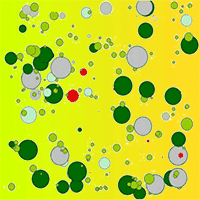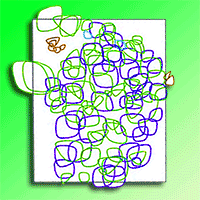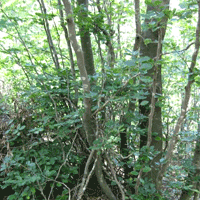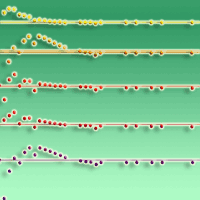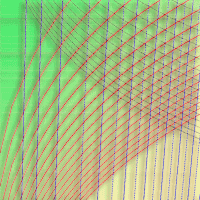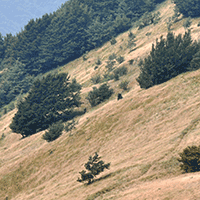
Structure and dynamics of a beech forest in a fully protected area in the northern Apennines (Sasso Fratino, Italy)
L Bianchi (1) , A Bottacci (2), G Calamini (1), A Maltoni (1), B Mariotti (1), G Quilghini (3), F Salbitano (1), A Tani (1), A Zoccola (2), M Paci (1)
iForest - Biogeosciences and Forestry, Volume 4, Issue 3, Pages 136-144 (2011)
doi: https://doi.org/10.3832/ifor0564-004
Published: Jun 01, 2011 - Copyright © 2011 SISEF
Research Articles
Abstract
Sasso Fratino Nature Reserve (National Park of Casentino Forests, northern Apennines) is a quite rare example of natural Apennine forest. The Reserve was established in 1959, aiming to protect a forest, although not a virgin one, low-intensively disturbed in the past by comparison with other neighbouring stands. Causes of such a low disturbance are the very limited accessibility of the area due to the very steep slopes characterising the site morphology, as well as historical features. The forest is a pure beech stand from 1250 m a.s.l. upwards, below this altitude is a mixed beech and silver fir forest. The study focuses on the understanding of the processes driving the evolution of the forest in the absence of human activities. To achieve this goal, 9 permanent, long-term research plots were established at different altitudes, in order to investigate on forest dynamics and regeneration processes. Simplified (single-layer) stand structures are more frequent where canopy gaps are absent. Two-layered structures are the result of the occurrence of canopy gaps, which allow the settlement, and subsequently the establishment, of a lower regeneration layer. Where the gap dimensions allow canopy closure, this kind of structure persists. When the gaps are quite large, the regeneration layer reaches the top layer and the structure stand tends, once more, toward a single-layer. Multilayered structures are extremely rare at plot level and become evident only at a wider scale. Our surveys indicate also a high variability of tree diameter distribution patterns in the forest stands. Such variability could be strictly related to the heterogeneity of site characteristics as well as to the effects of disturbance factors (both natural and anthropic). Concerning altitude, we observed an increase both of site index (dominant height) and species diversity in the regeneration layer, moving from higher (1500 m) to lower (900 m) altitudes. As a whole, our observations show that the dynamics of forest vegetation in the reserve is mostly affected by the interruption of tree canopy continuity. This implies substantial local variations of PAR in space and in time, which determine favourable ecological conditions for: (a) survival and growth of beech seedlings, or release of advanced beech regeneration; and (b) release of advanced silver fir regeneration (fir, more shade tolerant than beech, regenerates mainly in locations and conditions where the broadleaf saplings cannot survive for lack of light). The knowledge of the mechanisms of vegetation dynamics in the Reserve can be used to form the basis of close-to-nature silvicultural choices in similar stands in order to increase functionality and stability. Periodical monitoring of RNI will allow the investigation of the evolutionary trends of the forest stands.
Keywords
Old growth forest, Forest stand dynamics, Beech - Silver fir mixed stand, Forest management
Authors’ Info
Authors’ address
G Calamini
A Maltoni
B Mariotti
F Salbitano
A Tani
M Paci
DEISTAF, University of Florence, FI (Italy)
CFS, UTB Follonica, GR (Italy)
Corresponding author
Paper Info
Citation
Bianchi L, Bottacci A, Calamini G, Maltoni A, Mariotti B, Quilghini G, Salbitano F, Tani A, Zoccola A, Paci M (2011). Structure and dynamics of a beech forest in a fully protected area in the northern Apennines (Sasso Fratino, Italy). iForest 4: 136-144. - doi: 10.3832/ifor0564-004
Paper history
Received: Nov 15, 2010
Accepted: Mar 03, 2011
First online: Jun 01, 2011
Publication Date: Jun 01, 2011
Publication Time: 3.00 months
Copyright Information
© SISEF - The Italian Society of Silviculture and Forest Ecology 2011
Open Access
This article is distributed under the terms of the Creative Commons Attribution-Non Commercial 4.0 International (https://creativecommons.org/licenses/by-nc/4.0/), which permits unrestricted use, distribution, and reproduction in any medium, provided you give appropriate credit to the original author(s) and the source, provide a link to the Creative Commons license, and indicate if changes were made.
Web Metrics
Breakdown by View Type
Article Usage
Total Article Views: 62855
(from publication date up to now)
Breakdown by View Type
HTML Page Views: 52209
Abstract Page Views: 3694
PDF Downloads: 5378
Citation/Reference Downloads: 33
XML Downloads: 1541
Web Metrics
Days since publication: 5318
Overall contacts: 62855
Avg. contacts per week: 82.74
Citation Metrics
Article Citations
Article citations are based on data periodically collected from the Clarivate Web of Science web site
(last update: Mar 2025)
Total number of cites (since 2011): 24
Average cites per year: 1.60
Publication Metrics
by Dimensions ©
Articles citing this article
List of the papers citing this article based on CrossRef Cited-by.
References
Ecologia strutturale e funzionale di faggete italiane (Scarascia Mugnozza G ed). Edagricole Calderini, Bologna (Italy).
Gscholar
Quantifying diameter distributions with the weibull function. Forest Science 19 (2): 97-104.
Gscholar
Aspetti storici. La riserva naturale integrale di Sasso Fratino 1959-2009: 50 anni di conservazione della biodiversità (Bottacci A ed). Corpo Forestale dello Stato-Ministero delle Politiche Agricole Alimentari e Forestali. Arti grafiche Cianferoni, Stia, AR (Italy), pp. 29-38.
Gscholar
Die reaktion von Buchensämlingen auf beschattung. Forstarchiv 35 (11): 225-233.
Gscholar
Nature-based silviculture in Slovenia: origins, development and future trends. Nature-based forestry in central Europe - Alternatives to industrial forestry and strict preservation. In: “Nature-based forestry in central Europe, alternatives to industrial forestry and strict preservation” (Diaci J ed). Studia For. Slov. 126: 119-131.
Gscholar
Vegetation ecology of central Europe. Cambridge University Press, Cambridge, UK.
Gscholar
La storia della Foresta Casentinesi nelle carte dell’Archivio dell’Opera del Duomo di Firenze dal secolo XIV al XIX. Collana Verde n° 43, MAF, Rome, Italy.
Gscholar
L’opera rinnovatrice di Carlo Siemoni selvicoltore Granducale. Ann. Acc. It. Sci. For. 27: 173-194
Gscholar
Secondo contributo alla conoscenza della flora della Riserva Naturale Integrale di Sasso Fratino (Parco Nazionale delle Foreste Casentinesi, Monte Falterona e Campigna). In: “La Riserva Naturale Integrale di Sasso Fratino: 1959-2009. 50 anni di conservazione della biodiversità ” (Bottacci A ed). Corpo Forestale dello Stato, Ufficio Territoriale per la Biodiversità di Pratovecchio, Arezzo, Italy, pp. 75-118.
Gscholar
L’abieti-faggeto di Sasso Fratino ed i suoi aspetti fitosociologici. Tipografia Valbonesi, Forlì, Italy. Archivio botanico e biogeografico italiano XLI (4): 1-15.
Gscholar
Le stime di superficie 2005 - Prima parte. Inventario nazionale delle foreste e dei serbatoi forestali di carbonio (Tabacchi G, De Natale F, Di Cosmo L, Floris A, Gagliano C, Gasparini P, Genchi L, Scrinzi G, Tosi V eds). MiPAF, Corpo Forestale dello Stato, Ispettorato Generale, CRA - ISAFA, Trento.
Online | Gscholar
Forest dynamics. SILVI-STAR: a comprehensive monitoring system. Springer, Berlin, Germany.
Gscholar
Ricerche sui fattori della rinnovazione naturale dell’abete bianco sull’Appennino. L’Italia Forestale e Montana XXII (6): 261-270.
Gscholar
Prime indagini sulle caratteristiche dei soprassuoli della riserva naturale integrale di Sasso Fratino. L’Italia Forestale e Montana XXVII:156-165
Gscholar
The role of studies on vegetation dynamics in undisturbed natural reserves towards the need of knowledge for close-to-nature silvicultural treatments: the case-study of Natural Reserve of Sasso Fratino (Foreste Casentinesi, northern-central Apennines). AISF-EFI International Conference on “Forest management in designated conservation and recreation areas” (Morandini R, Merlo M, Paivinnen R eds). Florence (Italy) 7-11 October 1998. University of Padua Press, pp. 145-156.
Gscholar
Storia delle foreste demaniali casentinesi nell’Appennino tosco-romagnolo. Collana Verde n°63. M.A.F., C.F.S. ex ASFD, Rome, Italy.
Gscholar
Geobotanica. In: “Trattato di botanica” (Cappelletti C ed). UTET, Turin, Italy, pp. 801-997.
Gscholar
The life forms of plants and statistical plant geography. Clarendon, Oxford, UK.
Gscholar
Osservazioni sulle caratteristiche e l’evoluzione dei suoli della Foresta di Campigna (Forlì). Relazioni con la vegetazione forestale. Annali Accademia Italiana Scienze Forestali XI: 97-137.
Gscholar
Essentials of ecology (2nd edn.). Blackwell Publishing Company, UK.
Gscholar
Disturbance of microsites and early tree regeneration after windthrow in Swiss mountain forests due to the winter storm Vivian 1990. For. Snow Landsc. Res. 77: 17-47.
Gscholar

